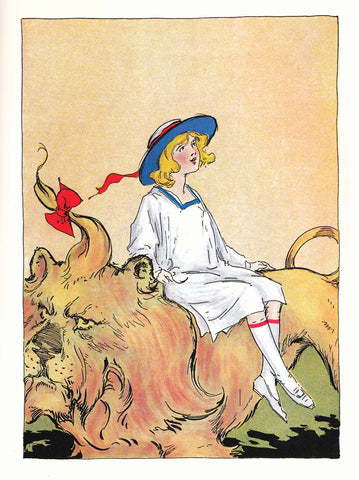 VISIT
MUSEUM STORE
MEMBERSHIP
OZ NEWS
CONTACT
VISIT
MUSEUM STORE
MEMBERSHIP
OZ NEWS
CONTACT
DISCOVERING OZ: THE ROYAL HISTORIES - “THE EMERALD CITY OF OZ”
THE EMERALD CITY OF OZ”
...AND HOW DOROTHY (AND ALL HER FRIENDS) DISAPPEARED, NEVER TO RETURN

[Above: The Scarecrow high-steps out of his new corncob mansion (solid gold, trimmed in and augmented by sparkling emeralds) to jubilantly greet extended family and friends. In the forefront of that faction are little Dorothy and the equally kickin’-it-across Tin Woodman.]
He was serious about it. L. Frank Baum planned and wrote -- and Reilly & Britton published -- his sixth Oz book as the culmination of what had become an unintentional series. The story was wonderful, marvelous, and stirring on multiple levels. It was also the most graphically elaborate Oz book since the first, eleven years earlier, and its sixteen full-color plates and cover label were adapted from unique, fantasy-come-to-life paintings by John R. Neill. Beyond that, those images were enhanced by random but glowing decorations of iridescent green ink. It was (to say it succinctly) a volume that warranted its title: THE EMERALD CITY OF OZ.

[Above: In 1910, the aware or wary child might have been given pause by this foreshadowing Neill picture: it was fashioned and positioned as the half-title leaf at the onset – page three! – of THE EMERALD CITY OF OZ.]
Baum himself took a new stylistic approach to an Oz tale when presenting his intended exit. In THE EMERALD CITY OF OZ, he combined two narratives, alternating adventures throughout the text until the plots intertwined and were finally resolved across the closing four of thirty chapters. [Note: He later continued in this fashion in three of his subsequent Oz titles -- THE LOST PRINCESS OF OZ, THE MAGIC OF OZ, and (to a certain extent) GLINDA OF OZ, with two simultaneous scenarios coalescing at their finales.] For EMERALD CITY’s “story one,” Baum brought back the ever-more-threatening Roquat the Nome King: furious, vindictive, and out-of-control. That monarch had never forgotten the manner in which Ozma, Dorothy & Company escaped him (in OZMA OF OZ, three years before), capturing his incomparable Magic Belt in the process.
In the sort of Baum “reportage” that left youngsters no doubt that Oz was a real, truly, live place, the author delivered his new, contemporary testimony: In THE EMERALD CITY OF OZ, Roquat seeks decisive revenge. Under counsel from the general of his armies, he decides to put one thousand Nome miners to work, tunneling below the Deadly Desert that customarily protects Oz from outside invaders. Such a passage would enable fifty-thousand Nome warriors to march through the underpass to then lay waste to the merriest kingdom in fantasy history – and to enslave all of its inhabitants. The latter, of course, included Ozma, Dorothy, the Scarecrow, Tin Woodman, Cowardly Lion, and dozens more, all substantially dear to the hearts of Baum’s countless readers.

[Above: The miserable and vile Nome King; no more needs to be said.]
However! Despite the Nome King’s euphoric reaction to the suggestion from his preeminent soldier, the cautious general himself ultimately concludes that conquering Oz would be an impossible task for the Nomes, and he chides the King for his overblown confidence in them. Baum concisely details Roquat’s renewed anger and ruthless hatred throughout this exchange and eventually tempers the situation with offhand humor. When the general unconditionally and conclusively refuses to lead such an army, the King summons his guards to “drag out the general and throw him away!” Roquat’s next prospective general quickly rejects the Oz job as well, whereupon the King condemns him to the torture chamber, where he’ll be thinly sliced and fed “to the seven-headed dogs.” (Baum conveys all of this in excellent relief to all the rapacious, pitiless renunciations of the Oz people by the King.)
Roquat’s third officer is nevertheless the charm. The new general, cannily named Guph (i.e., guff), takes the assignment and vows to enlist other, additional bands of malevolent, reprehensible creatures to augment the Nomes in their campaign to decimate Oz. Guph immediately leaves to visit their fearful countries and to wangle support from each populace.



[Above, from top: Here, artist Neill depicts representatives of the three countries of “evil creatures who have magic powers sufficient to destroy and conquer the Land of Oz.” The Whimsies possessed large, strong bodies and foul spirits, and they could not be killed. Contrarily, however, each Whimsie wore an enormous pasteboard head to conceal the fact that his own cranium was semi-brainless and miniscule -- no bigger than a doorknob. (The Neill drawing at top shows Guph with the Chief of the Whimsie tribe; notice the tiny holes in the latter’s pasteboard chin, which enabled the creature to look out of his faux head, at that level, with his own eyes.) The Growleywogs – above center – were gigantic: all bone, skin, and muscle, yet “the weakest . . . was so strong that he could pick up an elephant and toss it seven miles away.” Finally, the Phanfasms were “Erbs,” a breed of shapeshifters who could transform themselves into any combination of man, woman, beast, or being they selected. (Their leader, the First and Foremost, took the shape of a man with a bear’s head when “conferring” with General Guph, as shown in the third drawing above. Neill also indicates the eyes of hundreds of invisible Phanfasms as they intensely monitor the situation.) The Phanfasms remain the most despised, frightening, and powerful of all the nefarious creations Baum references in THE EMERALD CITY OF OZ; in league with the Whimsies, Growleywogs, and Nomes, there’s no question that their amalgamated forces would leave Oz a wasteland.]
Delighted to wreak havoc on the happiness of the Oz people, all of the malicious societies visited by Guph agree to help the Nomes, though demanding heavy rewards for their participation. Then – and privately, of course -- each atrocious clan plans to eliminate all the other warriors in addition to the Ozians. The Nome King has the same secret strategy: he’ll let the Whimsies, Growleywogs, and Phanfasms conquer and despoil Oz – and then he’ll do away with them.
Pleasant fellows.
Yet Baum’s reportage about all of these iniquitous machinations summarizes a real and serious threat to Oz, especially as it comes at a particularly propitious time in that glorious kingdom’s annals. The episodes and history so far described above are scattered across six chapters of THE EMERALD CITY OF OZ, intermingled with the first seven installments of “story two.” The latter is as uplifting and festive as it can be: Dorothy, Toto, and Uncle Henry and Aunt Em have just moved to Oz . . . to stay. 😊 Their Kansas farm has fallen into debt, the Gale family is about to be turned out, and the aunt and uncle are understandably distraught. Thus, niece Dorothy offers to move to Oz with her dog, knowing full well that when she gets there, she’ll have the Princess Ozma at hand to transport the elderly couple to the Emerald City as well. Such relocation would eliminate their financial burden and eradicate the need for them to work so hard in the fields of the Midwestern United States to provide themselves a home.


[Above top: In Kansas, Aunt Em and Uncle Henry are perplexed when they realize that Dorothy and Toto have actually disappeared from the girl’s attic room. Could there really BE a Land of Oz to which she says she will be summoned by Ozma’s magic? (This Neill picture – and the mysterious episode it illustrates – has long been a personal favorite here.) Above bottom: Dorothy Gale remains the quintessential Everychild and prize heroine of American fiction. (Sorry, Scarlett . . ..) Note, please, the amazing and Ozzy borderline details supplied by John R. Neill in his art.]
To acclimate the older couple to the glories of their new homeland, Baum ingeniously tracks their trek on an illuminating tour of diverse Ozian locales devised for them by Ozma. (These adventures are described in the midpoint chapters of the book, concurrent with the progress of the Nome King’s ever-encroaching tunnel to the Emerald City and General Guph’s encounters with the horrors that agree to join in the Oz annihilation.) Em and Henry board Ozma’s Red Wagon, accompanied by Dorothy, the Wizard of Oz, the Shaggy Man, Omby Amby (Captain General of Ozma’s nonexistent army), Toto, and Billina the Hen; their conveyance is pulled by the amiable and tireless Sawhorse. This makes for a joyous amalgamation of characters introduced in four of the preceding five Oz titles.
It’s a prodigious and jampacked excursion, yet Baum’s coverage of each new stop along the way never feels crammed or cramped. (A brief list and/or colorful picture will suffice here as further description/depiction of the visited locales.) The travelers call upon Professor Wogglebug at The Royal Athletic College of Oz, where students spend all their time in sports activities and gain their knowledge from School Pills invented by the Wizard. The tourists next proceed to the village of The Cuttenclips (living paper dolls) and to Fuddlecumjig (home of life-size, three-dimensional jigsaw-puzzle people). Later, they reach Rigamarole (where the verbose citizens never say in one word what might be said in fifty) and Flutterbudget (whose residents are in constant hysterics over what MIGHT happen to them or those ’round about). Meanwhile, and true to her tradition, Dorothy goes exploring on her own for a full day and manages side jaunts to Utensia (with its living kitchenware); to Bunbury (with its edible bread-dough and pastry populace and architecture); and to Bunnybury, where she sagely persuades a foolishly despondent and depressing rabbit king to enjoy his good fortune, his cheerful subjects, and his beautifully appointed kingdom.



[Above top: Miss Cuttenclip creates the people of her village out of “living” paper, presented to her by Glinda the Good. (Look closely and you’ll see that Neill’s original painting for this book plate displays samples and examples of decoupage.) Above center: Dorothy, Toto, and Billina are “captured” by the Utensia Spoon Brigade and escorted to trial; Baum shamelessly (not to say gleefully!) indulges a lifelong passion for cunning puns in this chapter. Above bottom: The morose and constantly complaining King of Bunnybury is seriously counseled by the little girl from Kansas. As a happy result, he promises -- “honor bright” -- to stop his “howls about being so miserable,” and to be “merry and gay all the time.”]
The jovial journey eventually brings the Emerald City travelers to the Tin Woodman’s castle. He is delighted to see them but is soon forced to convey the information about the coming invasion of (what today would be termed) “haters” through the Nome King’s tunnel. The next day’s trip to the Scarecrow’s beautiful new corncob tower enables the now somber party to also tell him this saddening information; the same thing happens at the giant pumpkin farm of Jack Pumpkinhead. These three magical Oz personalities climb aboard the Red Wagon as well, and all return to the capital to lend support to Ozma. The lovely and pacifistic girl ruler, however, refuses to prepare to fight her onrushing prospective assailants, and all seems lost for the land and lives cherished by so many.

[Above: The returning travelers and Oz celebrities join Ozma and Dorothy to despondently view, in the palace Magic Picture, the coming heathen hordes.]
And what happens? Well, I’ll be feisty and impudent about this . . . and simply state that THE EMERALD CITY OF OZ just MUST be read. 😊 Leave it to the brains of the Scarecrow, however, to suggest a possible solution – and leave it to the sorcery of the sublime Glinda the Good to offer a means of forever-protecting Oz from all future attack.
Thus Baum wraps up the sixth and (what he thought would be) conclusive Oz book. Its brief, final chapter offers a note that the author received from Dorothy; her message is quoted here, precisely as it appears in the text:

I first read THE EMERALD CITY OF OZ as a little boy sometime in the late 1950s. At that age, I already knew there were thirty-three (subsequently thirty-four) Oz books to come after 1910, so while I was dazzled by the concept of a communication from Dorothy Gale, her text didn’t haunt me. Some forty years later, however, I was privileged to include that specific message at the conclusion of the first chapter of 100 YEARS OF OZ (1999), a decade-by-decade history of the franchise/phenomenon, and all of it built around exceptional art and treasures from the Willard Carroll/Tom Wilhite collection. (That book was later expanded and reprinted in 2013 as THE WONDERFUL WORLD OF OZ.) Rereading and incorporating Dorothy’s message then, in 1999 and when I was in my late forties, I remember being moved to genuine tears at the idea that Oz might have, for real, “ended” there in THE EMERALD CITY OF OZ. There was a sudden, poignant realization of the loss and tragedy it would have been to billions of children – eventually including me -- to never again know any more about the history of the country and its unequaled people. Even in 1959 or so, many had long been among my very best childhood friends; and by 1999, it was a surety that they’d be among my Best Friends Forever.)
As noted, THE EMERALD CITY OF OZ was published in 1910 and immediately acclaimed. “This last Oz book is every bit as fascinating as are the other five,” according to the Milwaukee WISCONSIN. Referencing Baum’s “brilliant imagination and . . . his knowledge of the very best way to tell a good story,” the Chicago TRIBUNE also praised the “wonderful emerald pictures by [Neill], who knows just what fairyland is like.” The New York GLOBE opined that readers shouldn’t believe it was “Baum’s last Oz book . . . The children won’t have it,” and the Portland (Oregon) TRAVELER could only reference the publishers’ “announcement that causes tears to come to one’s eyes” -- and then flatly observe, “[Other] fairy nations are not Oz, and the children want it. The only graceful way Baum can quit telling tales of Oz is to die.”

[Four of the nine Reilly & Britton titles in this 1910 advertisement were Baum product. His JUVENILE SPEAKER (bottom right) was a compilation of prose and poetry excerpts from his earlier works, fashioned for interpretive performance by young readers, actors, or elocutionists. AUNT JANE’S NIECES ABROAD and THE BOY FORTUNE HUNTERS IN ALASKA were among his pseudonymous offerings for teen readers. THE EMERALD CITY OF OZ, of course, is spot-lit, top and center.]
But where to go from there? Baum and Reilly & Britton already had plans to launch (and had announced) a new fantasy series with a new heroine, her companion, and their own first book, to be published in 1911. Yet it seems that masterful Baum – across the preceding decade – had discovered a genuinely magical land and scores of its principal residents who had taken on unprecedented dimensions of reality. However unwittingly, he had chronicled genuine history for his readers, and they’d embraced, adopted, clung to, and reveled in joy-in-Oz as they had reacted to little else at that time.

[Above: In an acknowledgement that would have delighted his late mother-in-law -- superlative women’s-rights-activist Matilda Joslyn Gage -- Baum established in Oz a monumental matriarchy. Its most powerful, popular, and beloved caretakers, caregivers, and care keepers were three everlasting females: Glinda the Good, Princess Ozma, and Princess Dorothy Gale. This exquisite John R. Neill painting – the last full-color plate in the early editions of THE EMERALD CITY OF OZ -- pictures the three of them. Note as well, please, the Nome King, who is pretty much out of commission at the peak of the picture.]
I don’t think many people reading here will be surprised to hear that Frank Baum DID find a way to once again reach the otherwise suddenly and newly unattainable, undetectable, obscured, concealed, imperceptible, and invisible Land of Oz. It did, however, take him three years -- and why he found the way back (and how it happened that the magic of his own extraordinary handiwork reached out and, in effect, “saved” him) will be told in our next Vlog and Blog!
Thank you for reading. 😊
Article by John Fricke



